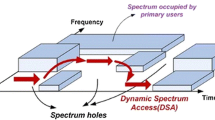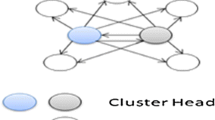Abstract
Forming collaborative wireless network clusters in dynamically changing environments is essential for cognitive radios to achieve such desired objectives as interference resilience and low communications overhead. In this paper, a novel approach to form efficient node clusters in an ad hoc cognitive radio network (CRN) is introduced based on the affinity propagation (AP) message-passing technique. With this approach, nodes exchange messages containing local network information with their direct neighbours until a high quality set of clusterheads and an efficient cluster structure emerges. The groupings are based on measures of similarity between the network nodes, which are selected based on application requirements. As an initial application, we show how the AP technique can be used to distributively determine cluster assignments and elect a small number of clusterheads that cover a CRN. Such an objective is commonly used to reduce communication overhead in key network functions such as resource management and routing table maintenance. To demonstrate the merits of the proposed approach, the clustering efficiency of the AP technique is evaluated on randomly generated open spectrum access scenarios. The simulation results demonstrate that the proposed approach provides a smaller number of clusters than a standard technique based on approximating the minimum dominating sets of the corresponding ad hoc network graphs.
Similar content being viewed by others
References
Yu J. Y., Chong P. H. (2005) A survey of clustering schemes for mobile ad hoc networks. IEEE Communication Surveys & Tutorials 7(1): 32–48
Chen Y. P., Liestman A. L., Liu J. (2006) Clustering algorithms for ad hoc wireless networks. In: Hauppage Y. P. (eds) Ad hoc and sensor networks. Nova Science Publishers, NY, pp 145–164
Zhao J., Zheng H., Yang G. (2007) Spectrum sharing through distributed coordination in dynamic spectrum access networks. Wireless Communications and Mobile Computing 7(9): 1061–1075
Sun, C., Zhang, W., & Ben Letaief, K. (2007). Cluster-based cooperative spectrum sensing in cognitive radio systems. In Proceedings of the IEEE International Conference on Communications, 2511–2515.
Chen T., Zhang H., Zhou X., Maggio G., Chlamtac I. (2007) CogMesh: A cluster based cognitive radio mesh network. In: Fitzek F., Katz M. (eds) Cognitive wireless networks. Springer, Dordrecht, The Netherlands, pp 657–678
Frey B., Dueck D. (2007) Clustering by passing messages between data points. Science 315(5814): 972–976
Akyildiz I. F., Lee W. Y., Vuran M. C., Mohanty S. (2006) Next generation/dynamic spectrum access/cognitive radio wireless networks: A survey. Computer Networks 50(13): 2127–2159
Fette B. A. (2006) Cognitive radio technology. Newnes, Newnes, Burlington, MA
Dueck, D. (2009). Affinity propagation: Clustering data by passing messages. Ph.D. dissertation, Department of Electrical & Computer Engineering, University of Toronto.
Bao, L., & Garcia-Luna-Aceves, J. J. (2003). Topology management in ad hoc networks. Proceedings of the 4th ACM International Symposium on Mobile Ad Hoc Networking and Computing, 129–140.
Garey M. R., Johnson D. S. (1979) Computers and intractability: A guide to the theory of NP-completeness. W.H. Freeman & Company, San Francisco, CA
Baker D. J., Ephremides A. (1981) The architectural organization of a mobile radio network via a distributed algorithm. IEEE Transactions on Communications 29(11): 1694–1701
Gerla M., Tsai J. T. (1995) Multiuser, mobile, multimedia radio network. Wireless Networks 1(3): 255–265
Wang K., Zhang J., Li D., Zhang X., Guo T. (2007) Adaptive affinity propagation clustering. Acta Automatica Sinica 33(12): 1242–1246
Fabbri, F., & Verdone, R. (2009). The impact of correlated channel fluctuations on the connectivity of wireless ad-hoc networks. In Proceedings of the IEEE 69th Vehicular Technology Conference, 1–5.
Franceschetti M., Meester R. (2007) Random networks for communication: From statistical physics to information systems. Cambridge University Press, Cambridge, UK
Wang Y., Wang W., Li X. (2006) Efficient distributed low-cost backbone formation for wireless networks. IEEE Transactions on Parallel and Distributed Systems 17(7): 681–693
Chvatal V. (1979) A greedy heuristic for the set-covering problem. Mathematics of Operations Research 4(3): 233–235
Author information
Authors and Affiliations
Corresponding author
Additional information
Parts of this paper have been presented at the 2nd Workshop on Cognitive Networks and Communications (COGCOM 2009).
Rights and permissions
About this article
Cite this article
Baddour, K.E., Üreten, O. & Willink, T.J. A Distributed Message-passing Approach for Clustering Cognitive Radio Networks. Wireless Pers Commun 57, 119–133 (2011). https://doi.org/10.1007/s11277-010-0010-z
Published:
Issue Date:
DOI: https://doi.org/10.1007/s11277-010-0010-z




